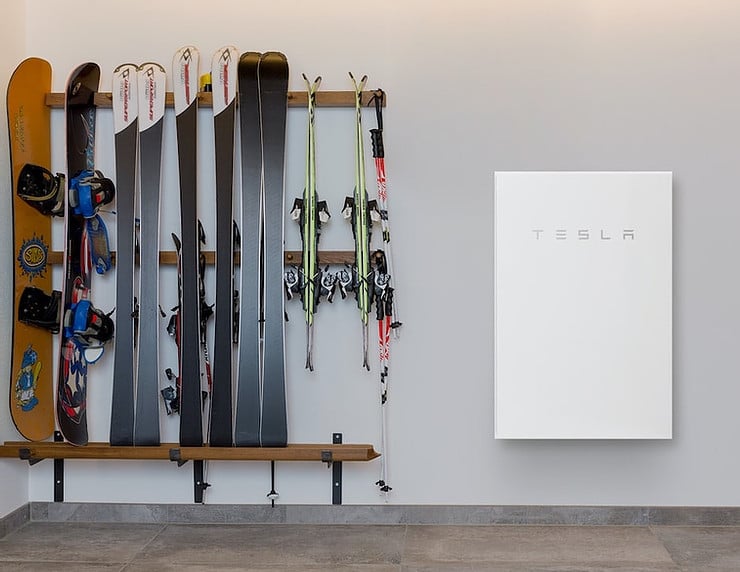Updated: Aug 28, 2020
Find out if a solar panel and battery combo is right for you. Plus, we address one of the biggest solar misconceptions out there. (Hint: It’s about power outages!)

Photo courtesy of Tesla
36% of solar shoppers consider adding a solar power battery backup in Vermont, according to a recent industry survey. And with plenty of good reasons. Solar energy storage offers peace of mind, helps ensure that your system will always run, and has never been more accessible to homeowners.
At Green Mountain Solar, we offer both Tesla Powerwall and Enphase Ensemble batteries. (See our product page to learn more about the specific differences between brands.) Our experts at Green Mountain Solar explain the ins and outs of these resilient energy systems.
Protect Your Home from Power Outages
The most recent data shows that the average Vermonter experienced 15 hours of power outages in 2018, according to the U.S. Energy Information Administration making our state second for the longest electrical interruptions in the country.
Wouldn't it be nice to never worry about another blackout? “Homeowners like having security knowing that they have, effectively, a future-proof system,” says Rob Dunn, Project Manager and experienced battery installer at Green Mountain Solar. “It will keep your lights going, keeps your essential loads going (like your fridge, a well pump, etc)—it can keep your entire house going if you have enough of them.”
Best of all, this happens without you having to do anything. “It is 100% automatic,” Rob adds. “And you can see it from your phone. So, if you’re not home, you can check the app.” It uses 3G/4G cell signal, Wi-Fi, and ethernet, so even your internet goes down with the powerlines, you’ll still be able to see when your house is in backup power mode or not. “You could be on vacation and see that you had a storm and the power went out and your house is running on the Powerwall.”
Solar advisor Marcus Shapiro shares how this kind of security can mean different things for different clients. “I had one potential customer who was very interested in the ideas of batteries because they have an Air B-n-B,” he said. “They’re looking to install batteries so that they don’t have any issues with guests if they do lose power—and they have lost power there quite often.”
But Wait. I Have Solar—Will Solar Panels Work in a Power Outage?
“The biggest misconception in the solar industry is that people think that when the grid goes down their solar is still going to be producing power for their house,” says Marcus. “This isn’t the case.”
For most systems, the extra power you don’t use at home gets sent back to the grid so you can sell it for net metering. Unfortunately, this becomes a safety issue during an outage. The live electricity could electrocute a utility worker who is doing repairs on the grid. So, when panels detect an outage, they shut off.
But, if you have a solar power battery backup, that’s not the case, Rob explains: “As the grid goes down, the battery disconnects your house from the grid and creates an isolated island where your panels can keep running,” without putting anyone at risk.
What Can I Run with a Battery?
"A lot of people just want their critical loads—fans running for their furnace, well pump, internet, lights,” says Marcus, but batteries can be adaptable to meet your needs. (“I had one customer recently… he’ll have enough panels and back up he can essentially run his house like it’s off-grid from spring through fall!”)
Marcus does note that heavier loads aren’t always supported by backup power. “Any breaker over 30 amps, we can’t do with one Powerwall,” he says. For instance, an electric drier is too large (so, sorry, no laundry during a power outage), but an electric stove is fine as long as you’re not running all of your burners at the same time. “To be realistic, if you’re cranking a heat pump in the winter, you’re going to drain your batteries in a matter of hours.” This is why it’s important to work with a seller who considers your energy usage when recommending a system.
Should I Buy a Generator for My House?
“You can get a manual generator—you know, pull the cord to start it—and, truthfully, those are not that expensive,” says Marcus. “But if you’re looking for a whole-home generator that automatically flips on when the power goes out, those are pretty expensive. A battery is going to kick on within 1/100 of a second without even a flicker of the lights. To look at a generator that does the same function, you’re looking at a lot of money.”
Generators also require regular maintenance—oil changes, annual service, replacing filters and spark plugs. Modern solar panel energy storage, on the other hand, have basically no upkeep. This is a big improvement over past battery technology. Old batteries were much more finicky (needed to maintain a certain charge, be equalized now and then, and even have water added). Current battery technology is set it and forget it.
And, of course, generators run on fossil fuels—not great if you’re going solar to shrink your carbon footprint.
Another Upside: Energy Independence
Batteries have a self-consumption mode so when your panels stop producing power when the sun goes down, you’ll pull from the battery instead. This means that you get to use the power you make right at home rather than sending it back into the grid.
Marcus adds that this also offers a new kind of security for customers. “In light of current events and the pandemic, a lot of people are feeling less confident in the state of the world and the state of the utility,” he says. Because batteries keep your solar panels on during an outage, there’s a greater sense of security knowing that your home doesn’t have to rely on the grid. “A lot of people want to have that freedom in a worst-case scenario.”
How Long do Solar Batteries Last?
Current battery technology is built to last much longer than old-school systems. The grid-tied solar energy storage batteries Green Mountain Solar offers all come with a 10-year warranty, though our experts suspect they’ll last you beyond that. “At that 10-year warranty, it’s assumed you’ll still have 70-90% of your original capacity depending on how you use it,” says Rob. “So, the likelihood of a homeowner to want to replace their system after 10 years is very slim.”
Tesla Powerwalls have an unlimited cycle life for the 10-year warranty. “That means that you can cycle it as much as you want in backup mode or self-consumption mode and it’s still covered under the warranty for 70% of the original capacity for that whole 10 years,” he says. “For these modes, it would be physically impossible to hit a cycle count that is greater than 2,800, so therefore Tesla just says a blanket statement that you do not need to consider cycles. It’s just a flat 10 years.”
Enphase batteries also come with a 10-year warranty. “The Enphase batteries do have a cycle limit, but if you did a true apples to apples comparison between the systems, it works out to be identical to Tesla’s 2,800 cycles,” Rob explains. “Which, when it’s in battery backup mode or self-consumption mode, is effectively impossible to hit before the 10-year warranty is up.”
What Do I Need to Know about Solar Energy Storage in Vermont?
One thing to consider when getting solar energy storage in Vermont is where you’ll install it—and how cold it gets there. “We only install a battery in a space that's heated and cooled to stay roughly between 50- and 82-degrees Fahrenheit,” explains Rob. “If you’re outside that window, you lose a little bit of efficiency, a little bit of charge capacity, discharge capacity.” Most of the time, this means Green Mountain Solar installs batteries in a basement or a heated or insulated garage.
Fortunately, current battery technology is much smaller than old batteries, so it’s easy to fit into these spaces. “When comparing a lead acid bank to Powerwall, the Powerwall is roughly 1/8th of the total volume,” says Rob. “It used to be that an old-school system was a battery cabinet that was 2 feet tall, four feet wide and up to 8 feet long—and that’s a very similar energy capacity as one to two Powerwalls.” One Powerwall, for comparison, is only 45 inches tall, 30 inches wide, and 6 inches deep (approximately).
And Tesla Powerwall has features that further help homeowners work around this limitation. “Based on the ambient temperature of the space, Powerwall can internally, bring up or down the temperatures of the cells in the battery itself to allow it to function outside of those optimal temperatures.”
By Julia Westbrook

Leave a Comment